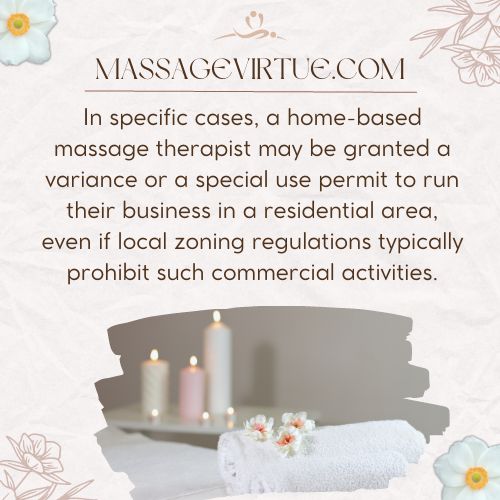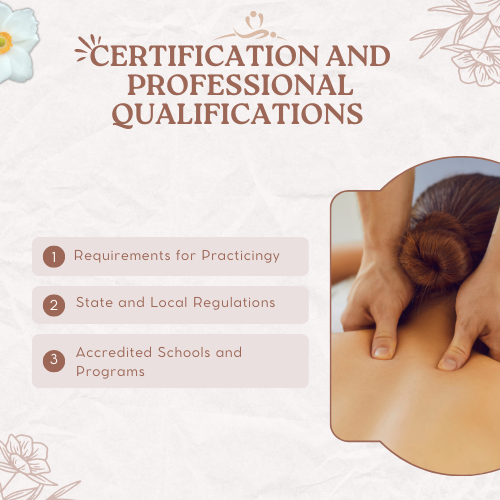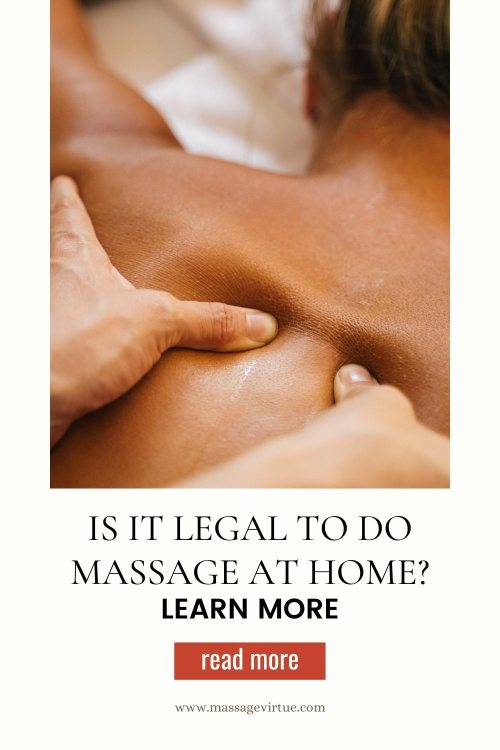With the increasing popularity of massage therapy as a means of relaxation and self-care, many individuals are considering the idea of offering massage services at home.
But before setting up a makeshift massage studio in your living room, it’s essential to address the legality of such a venture. Is it legal to do a massage at home?
In this article, we’ll explore the legal aspects surrounding home-based massage practices.
Is it Legal to do Massage at Home?
The answer to whether it is legal to do massage at home can be both yes and no, depending on the state or jurisdiction you are in.
However, even if it is allowed, there are legal perspectives, hygiene practices, and certification and training requirements that must be met to ensure compliance and maintain a high standard of professionalism.
Home-based massage therapists need to research and adhere to the specific laws and regulations in their state, as well as prioritize the safety and well-being of their clients through proper training and hygiene practices.
Understanding the Legal Landscape of Home-Based Massage Therapy
As home-based massage therapy gains popularity, it becomes crucial to delve into the legal landscape surrounding this practice.
Zoning Regulation and Home-Based Business:
Zoning laws often restrict or regulate commercial activities from taking place in residential areas.
This is primarily to maintain the residential character of neighborhoods and prevent potential disruptions caused by commercial operations, such as increased traffic, noise, or parking issues.
As a result, running a home-based business, including providing massage services, might not be allowed in certain residential zones.
Checking with Local Authorities:
Before starting a home-based massage business, it is vital to research and understand the specific zoning regulations in the area where the residence is located.
This involves reaching out to local authorities, such as the city planning department or zoning board, to inquire about the permissible uses for residential properties.
Consequences of Non-Compliance:
If a home-based massage therapist operates in a residential area without the necessary permits or violates the zoning restrictions, there can be serious consequences:
- Fines and Penalties: Local authorities may issue fines for non-compliance with zoning laws. The amount of the fine may vary depending on the severity of the violation and the local regulations.
- Cease and Desist Orders: Authorities can issue a cease and desist order, which requires the therapist to stop all business operations immediately until the zoning compliance is resolved.
- Legal Action: In some cases, persistent violations of zoning laws could lead to legal actions, including court orders to halt business operations or potential lawsuits brought by affected neighbors or community members.
Seeking a Variance or Special Use Permit:
In certain situations, a home-based massage therapist may be able to obtain a variance or a special use permit to operate a business in a residential area, even if it is not typically allowed by zoning regulations.

However, obtaining such permits usually involves a formal application process and may require demonstrating that the business will not significantly disrupt the neighborhood’s residential character.
Health and Safety Considerations for Massage at Home
1. Sanitation and Hygiene Standards
Maintaining a clean and hygienic environment is a fundamental aspect of any massage practice, ensuring the safety and well-being of both the massage therapist and the client.
In a home-based setting, practitioners must implement rigorous sanitation practices to uphold professional standards and provide a safe experience.
Regular Disinfection of Massage Equipment:
Home-based massage therapists should adopt a strict routine of cleaning and disinfecting all massage equipment after each session.
This includes massage tables, chairs, headrests, bolsters, and any other tools used during treatments.
Disinfectants or cleaning solutions recommended by health authorities should be used to effectively eliminate germs and bacteria.
Using Clean Linens for Each Client:
It is essential to provide fresh, laundered linens for every client. Clean sheets, towels, and blankets should be used for each massage session to prevent cross-contamination and maintain hygiene standards.
Used linens should be immediately placed in designated laundry containers for proper washing and disinfection.
Proper Hand Hygiene:
Massage therapists must prioritize hand hygiene to prevent the transmission of germs and maintain a clean environment.
Before and after each massage session, therapists should thoroughly wash their hands with soap and water for at least 20 seconds.
Alternatively, alcohol-based hand sanitizers with at least 60% alcohol can be used when handwashing facilities are not readily available.
2. Adherence to Industry Guidelines
In addition to implementing their sanitation protocols, home-based massage therapists should adhere to industry guidelines and recommendations provided by relevant health authorities or professional massage associations.
These guidelines are developed based on scientific research and best practices to ensure the safety and well-being of clients.
Relevant Health Authorities:
National and local health authorities, such as the Centers for Disease Control and Prevention (CDC) in the United States or similar agencies in other countries, often provide guidelines on sanitation and hygiene practices applicable to massage therapy.
These guidelines may encompass infection control measures and cleaning protocols to mitigate the risk of disease transmission.
Professional Massage Associations:
Recognized massage associations, such as the American Massage Therapy Association (AMTA) or the Associated Bodywork & Massage Professionals (ABMP), also publish industry-specific guidelines and recommendations for maintaining a clean and safe massage environment.
These guidelines typically align with health authority recommendations and offer additional insights into best practices for massage therapists.
Certification and Professional Qualifications

1. Requirements for Practicing Massage Therapy
The path to becoming a licensed or certified massage therapist varies depending on the jurisdiction in which one intends to practice.
Each region may have specific requirements that aspiring home-based massage therapists must fulfill to legally operate their business.
These requirements typically encompass various aspects, including education, training, and examinations.
Completion of Training Hours:
Many jurisdictions require individuals to complete a certain number of training hours (between 500 and 1000) from an accredited massage therapy program.
The training hours often cover various massage techniques, anatomy, physiology, ethics, and client communication.
Passing Examinations:
Some regions mandate passing standardized examinations to assess the therapist’s knowledge and competence in the field of massage therapy.
These exams may cover theoretical knowledge, practical skills, and ethical principles.
Specific Educational Qualifications:
In addition to completing training hours and passing examinations, some areas may have specific educational qualifications that individuals must meet to become licensed or certified massage therapists.
One common requirement is obtaining a high school diploma or an equivalent level of education.
2. Researching State and Local Regulations
Prospective home-based massage therapists must conduct thorough research to understand the specific regulations and requirements imposed by their state or local authorities.
Since regulations can vary significantly from one location to another, understanding the legal framework is essential for ensuring compliance.
State Licensing Boards:
State licensing boards are the primary source of information regarding massage therapy regulations.
These boards provide detailed information about the requirements for licensure or certification in each state.
Local Health Departments:
In some cases, local health departments or municipal authorities may have specific regulations or additional permits related to home-based massage practices.
It is important to contact these entities to inquire about any additional requirements.
3. Accredited Schools and Programs:
Enrolling in recognized massage therapy schools or programs accredited by reputable organizations is crucial for ensuring that the education received meets industry standards and is widely recognized by licensing bodies.
Accreditation Bodies:
Accreditation is typically provided by recognized organizations in the field of massage therapy, such as the Commission on Massage Therapy Accreditation (COMTA) or the Accrediting Commission of Career Schools and Colleges (ACCSC).
Conclusion
In conclusion, home-based massage therapy offers numerous advantages, including convenience, personalized experiences, and reduced overhead costs.
However, it also comes with challenges like limited space and the need for legal compliance.
While the answer to “Is it legal to do massage at home?” varies depending on the state or jurisdiction, thorough research, professionalism, and a dedication to client well-being are essential to ensure legality and success in this rewarding career choice.
By following local regulations and prioritizing client safety, home-based massage therapists can provide comfort and healing in the familiar and intimate setting of their client’s homes.
FAQs
1. Is it legal to do a massage at home?
Some areas permit home-based massage therapy, while others may have restrictions or prohibitions. It is crucial to research and comply with local laws and regulations to ensure legal operation.
2. What are the advantages of home-based massage therapy?
Home-based massage therapy offers several advantages, including:
- Convenience for clients who can avoid traveling to a separate location.
- Personalized experiences in a familiar and comfortable environment.
- Reduced overhead costs compared to operating from commercial studios.


